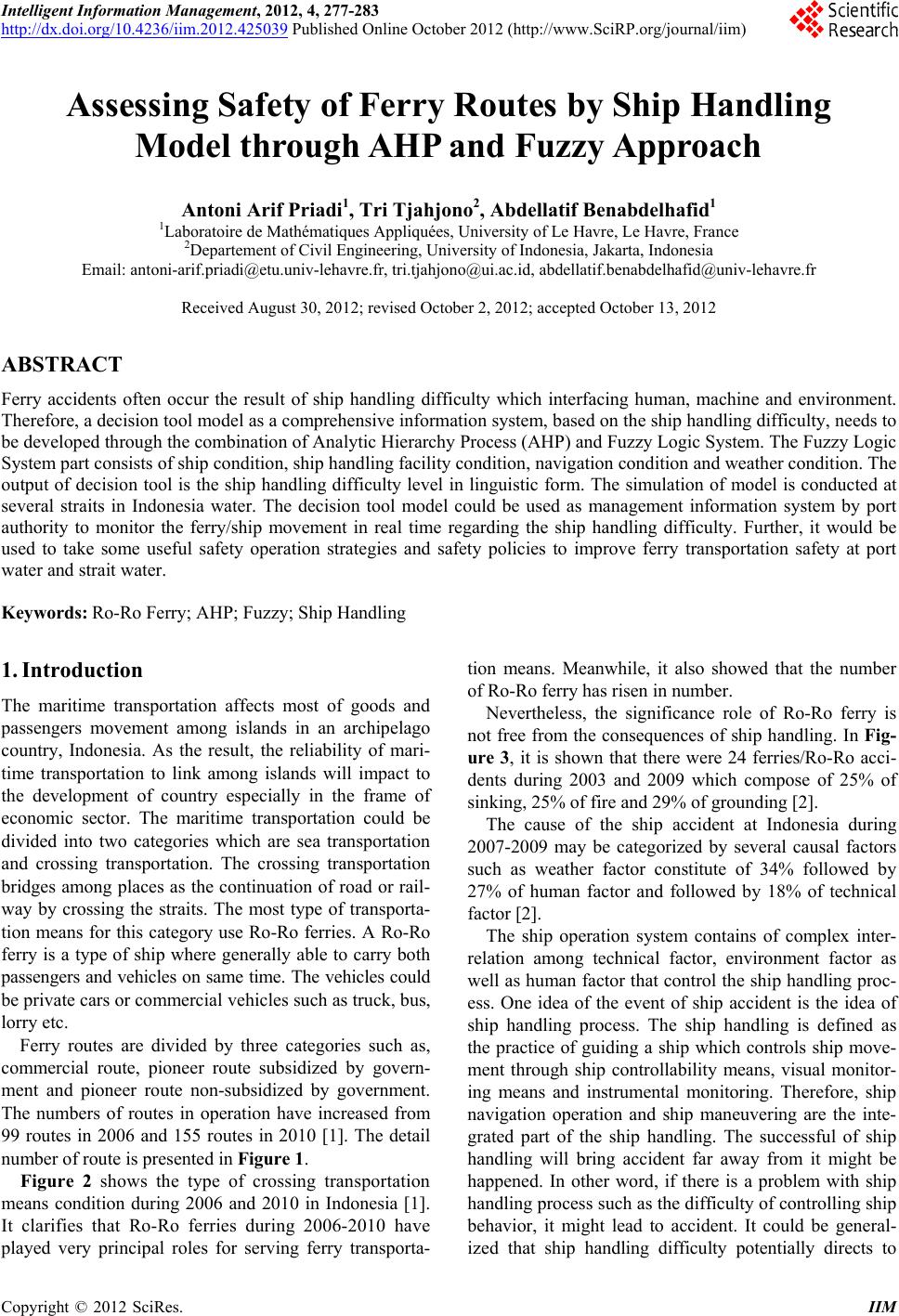 Intelligent Information Management, 2012, 4, 277-283 http://dx.doi.org/10.4236/iim.2012.425039 Published Online October 2012 (http://www.SciRP.org/journal/iim) Assessing Safety of Ferry Routes by Ship Handling Model through AHP and Fuzzy Appr oach Antoni Arif Priadi1, Tri Tjahjono2, Abdellatif Benabdelhafid1 1Laboratoire de Mathématiques Appliquées, University of Le Havre, Le Havre, France 2Departement of Civil Engineering, University of Indonesia, Jakarta, Indonesia Email: antoni-arif.priadi@etu.univ-lehavre.fr , tri.tja hjono@ui.ac.id, abde llatif.benabdelhafid@univ-lehavre.fr Received August 30, 2012; revised October 2, 2012; accepted October 13, 2012 ABSTRACT Ferry accidents often occur the result of ship handling difficulty which interfacing human, machine and environment. Therefore, a decision tool model as a comprehensive information system, b ased on the sh ip handling d ifficulty, need s to be developed through the combination of Analytic Hierarchy Process (AHP) and Fuzzy Logic System. The Fuzzy Logic System part consists of ship condition, ship handling facility conditio n, navigation condition and weather condition. The output of decision tool is the ship handling difficulty level in linguistic form. The simulation of model is conducted at several straits in Indonesia water. The decision tool model could be used as management information system by port authority to monitor the ferry/ship movement in real time regarding the ship handling difficulty. Further, it would be used to take some useful safety operation strategies and safety policies to improve ferry transportation safety at port water and strait water. Keywords: Ro-Ro Ferry; AHP; Fuzzy; Ship Handling 1. Introduction The maritime transportation affects most of goods and passengers movement among islands in an archipelago country, Indonesia. As the result, the reliability of mari- time transportation to link among islands will impact to the development of country especially in the frame of economic sector. The maritime transportation could be divided into two categories which are sea transportation and crossing transportation. The crossing transportation bridges among places as the continuation of road or rail- way by crossing the straits. The most type of transporta- tion means for this category use Ro-Ro ferries. A Ro-Ro ferry is a type of ship where generally able to carry both passengers and vehicles on same time. The vehicles could be private cars or commercial vehicles such as truck, bus, lorry etc. Ferry routes are divided by three categories such as, commercial route, pioneer route subsidized by govern- ment and pioneer route non-subsidized by government. The numbers of routes in operation have increased from 99 routes in 2006 and 155 routes in 2010 [1]. The detail number of route is presented in Figure 1. Figure 2 shows the type of crossing transportation means condition during 2006 and 2010 in Indonesia [1]. It clarifies that Ro-Ro ferries during 2006-2010 have played very principal roles for serving ferry transporta- tion means. Meanwhile, it also showed that the number of Ro-Ro ferry has risen in number. Nevertheless, the significance role of Ro-Ro ferry is not free from the consequences of ship handling. In Fig- ure 3, it is shown that there were 24 ferries/Ro-Ro acci- dents during 2003 and 2009 which compose of 25% of sinking, 25% of fire and 29% of grounding [2]. The cause of the ship accident at Indonesia during 2007-2009 may be categorized by several causal factors such as weather factor constitute of 34% followed by 27% of human factor and followed by 18% of technical factor [2]. The ship operation system contains of complex inter- relation among technical factor, environment factor as well as human factor that control the ship handling pro c- ess. One idea of the event of ship accident is the idea of ship handling process. The ship handling is defined as the practice of guiding a ship which controls ship move- ment through ship controllability means, visual monitor- ing means and instrumental monitoring. Therefore, ship navigation operation and ship maneuvering are the inte- grated part of the ship handling. The successful of ship handling will bring accident far away from it might be happened. In other word, if there is a problem with ship handling process such as the difficulty of controlling ship behavior, it might lead to accident. It could be general- ized that ship handling difficulty potentially directs to C opyright © 2012 SciRes. IIM 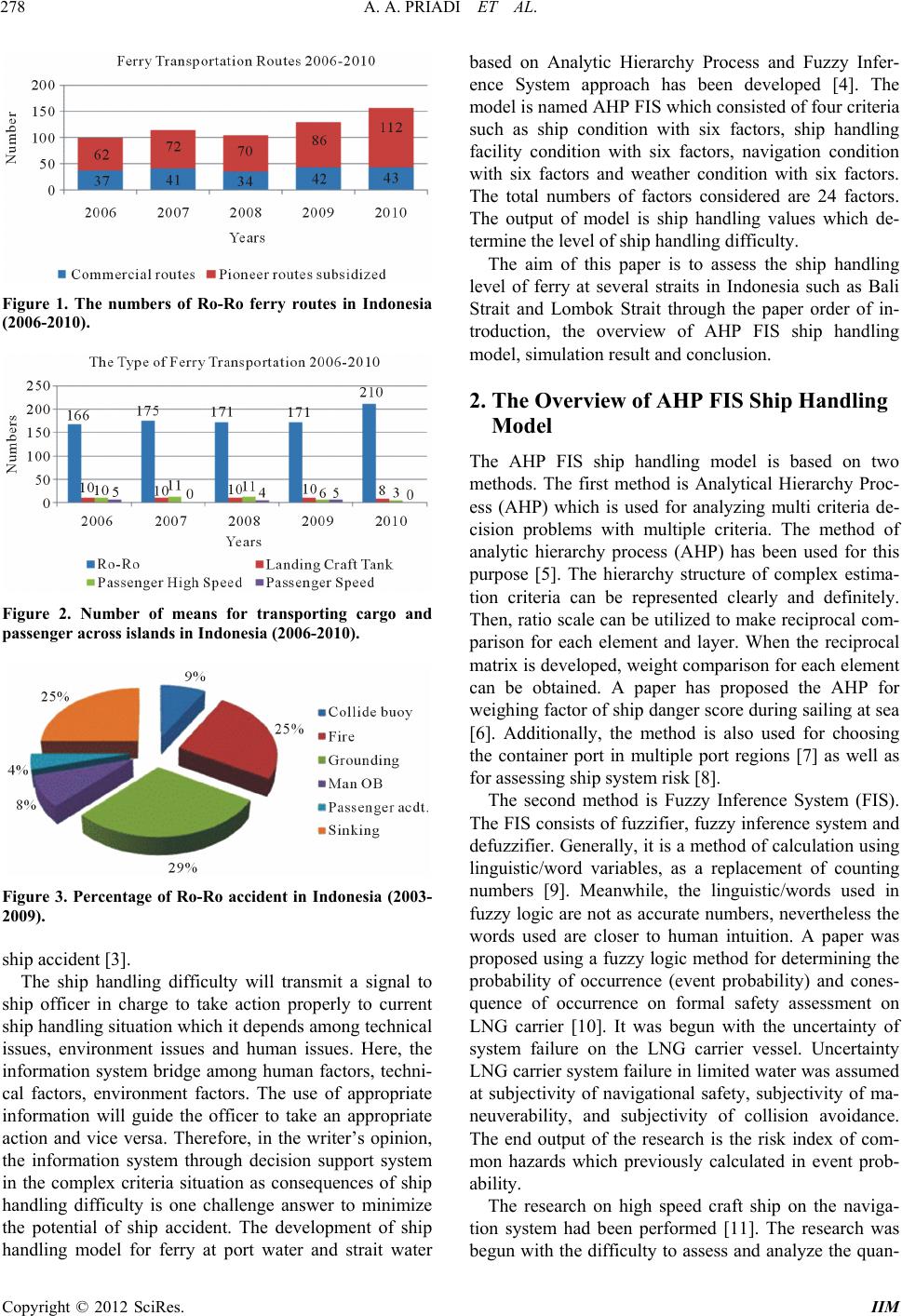 A. A. PRIADI ET AL. 278 Figure 1. The numbers of Ro-Ro ferry routes in Indonesia (2006-2010). Figure 2. Number of means for transporting cargo and passenger across islands in Indonesia (2006-2010). Figure 3. Percentage of Ro-Ro accident in Indonesia (2003- 2009). ship accident [3]. The ship handling difficulty will transmit a signal to ship officer in charge to take action properly to current ship handling situation which it depends among technical issues, environment issues and human issues. Here, the information system bridge among human factors, techni- cal factors, environment factors. The use of appropriate information will guide the officer to take an appropriate action and vice versa. Therefore, in the writer’s opinion, the information system through decision support system in the complex criteria situation as consequences of ship handling difficulty is one challenge answer to minimize the potential of ship accident. The development of ship handling model for ferry at port water and strait water based on Analytic Hierarchy Process and Fuzzy Infer- ence System approach has been developed [4]. The model is named AHP FIS which consisted of four criteria such as ship condition with six factors, ship handling facility condition with six factors, navigation condition with six factors and weather condition with six factors. The total numbers of factors considered are 24 factors. The output of model is ship handling values which de- termine the level of ship handling difficulty. The aim of this paper is to assess the ship handling level of ferry at several straits in Indonesia such as Bali Strait and Lombok Strait through the paper order of in- troduction, the overview of AHP FIS ship handling model, simulation result and conclusion. 2. The Overview of AHP FIS Ship Handling Model The AHP FIS ship handling model is based on two methods. The first method is Analytical Hierarchy Proc- ess (AHP) which is used for analyzing multi criteria de- cision problems with multiple criteria. The method of analytic hierarchy process (AHP) has been used for this purpose [5]. The hierarchy structure of complex estima- tion criteria can be represented clearly and definitely. Then, ratio scale can be utilized to make reciprocal com- parison for each element and layer. When the reciprocal matrix is developed, weight comparison for each element can be obtained. A paper has proposed the AHP for weighing factor of sh ip danger score during sailing at sea [6]. Additionally, the method is also used for choosing the container port in multiple port regions [7] as well as for assessing ship system risk [8]. The second method is Fuzzy Inference System (FIS). The FIS consists of fuzzifier, fuzzy inference system and defuzzifier. Generally, it is a method of calculation us ing linguistic/word variables, as a replacement of counting numbers [9]. Meanwhile, the linguistic/words used in fuzzy logic are not as accurate numbers, nevertheless the words used are closer to human intuition. A paper was proposed using a fuzzy logic method for determining the probability of occurrence (event probability) and cones- quence of occurrence on formal safety assessment on LNG carrier [10]. It was begun with the uncertainty of system failure on the LNG carrier vessel. Uncertainty LNG carrier system failure in limited water was assumed at subjectivity of navigational safety, subjectivity of ma- neuverability, and subjectivity of collision avoidance. The end output of the research is the risk index of com- mon hazards which previously calculated in event prob- ability. The research on high speed craft ship on the naviga- tion system had been performed [11]. The research was begun with the difficulty to assess and analyze the quan- Copyright © 2012 SciRes. IIM 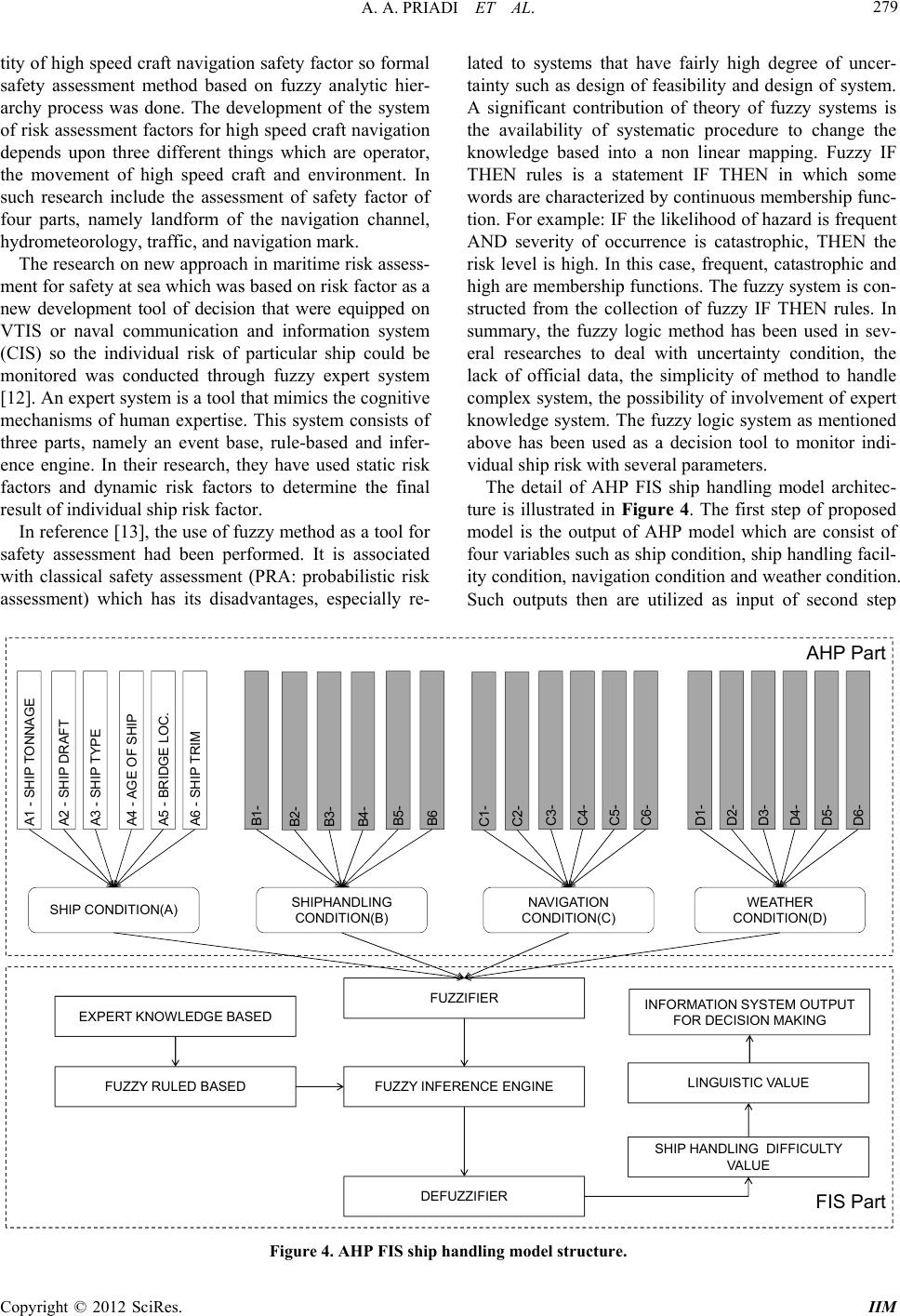 A. A. PRIADI ET AL. IIM 279 tity of high speed craft navigation safety factor so formal safety assessment method based on fuzzy analytic hier- archy process was done. The development of the system of risk assessment factors for high speed craft navigation depends upon three different things which are operator, the movement of high speed craft and environment. In such research include the assessment of safety factor of four parts, namely landform of the navigation channel, hydrometeorology, traffic, and navigation mark. The research on new approach in maritime risk assess- ment for safety at sea which was based on risk factor as a new development tool of decision that were equipped on VTIS or naval communication and information system (CIS) so the individual risk of particular ship could be monitored was conducted through fuzzy expert system [12]. An expert system is a tool that mimics th e cognitive mechanisms of human expertise. This system consists of three parts, namely an event base, rule-based and infer- ence engine. In their research, they have used static risk factors and dynamic risk factors to determine the final result of i ndividua l ship risk factor. In reference [13], the use of fuzzy method as a tool for safety assessment had been performed. It is associated with classical safety assessment (PRA: probabilistic risk assessment) which has its disadvantages, especially re- lated to systems that have fairly high degree of uncer- tainty such as design of feasibility and design of system. A significant contribution of theory of fuzzy systems is the availability of systematic procedure to change the knowledge based into a non linear mapping. Fuzzy IF THEN rules is a statement IF THEN in which some words are characterized by continuous membersh ip func- tion. For example: IF the likelihood of hazard is frequent AND severity of occurrence is catastrophic, THEN the risk level is high. In this case, frequent, catastrophic and high are membership functions. The fuzzy system is con- structed from the collection of fuzzy IF THEN rules. In summary, the fuzzy logic method has been used in sev- eral researches to deal with uncertainty condition, the lack of official data, the simplicity of method to handle complex system, the possibility of involvement of expert knowledge system. The fuzzy logic system as mentioned above has been used as a decision tool to monitor indi- vidual ship risk with several parameters. The detail of AHP FIS ship handling model architec- ture is illustrated in Figure 4. The first step of proposed model is the output of AHP model which are consist of four variables such as ship con dition, ship handling facil- ity condition, navigation conditio n and weather conditio n. Such outputs then are utilized as input of second step Copyright © 2012 SciRes. SHIP CO ND IT ION (A)SHIPHANDLING CONDITION(B) WEATHER CONDITI ON(D) NAVIGATI ON CONDITION(C) AHP Part FUZZY INFERENCE ENGINEFUZZY RULED BASED EXPERT KNOWLEDGE BASEDFUZZIFIER DEFUZZIFIER SHIP HAND LING DIFFICULTY VALUE LINGUISTIC VALUE A1 -SHIP TONNAGE A5 -B RID GE LOC. A4 -AGE OF SHIP A2 -SHIP DRAF T A3 -S HIP TY PE A6 -S HIP TRIM C3- C4- C5- C6- D1- D2- D3- D4- D5- D6- B1- B5- C1- C2- B2- B3- B4- B6 INFORMATION SY STEM OUTPUT FOR DECISION MAKING FIS Part Figure 4. AHP FIS ship handling model structure. 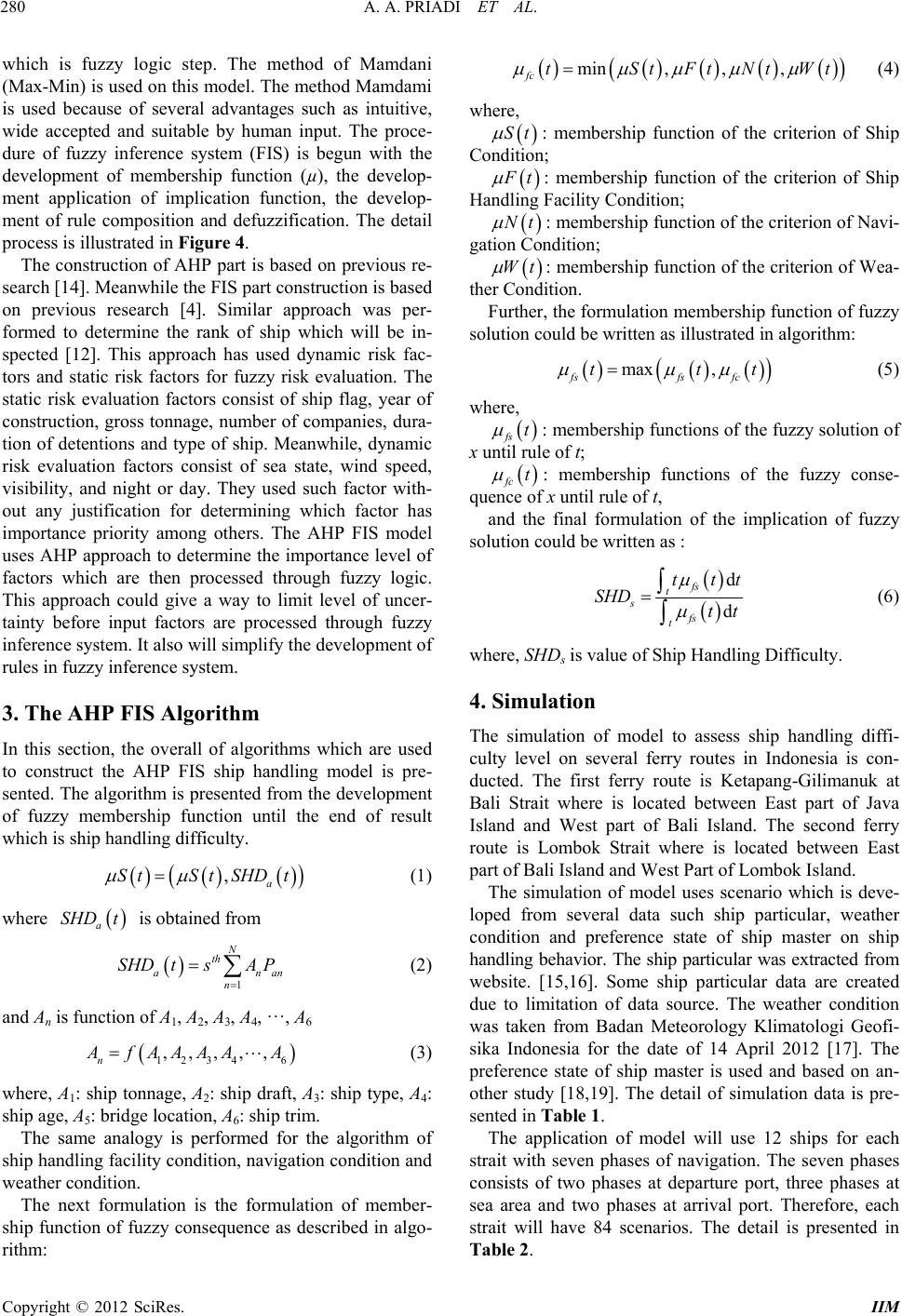 A. A. PRIADI ET AL. 280 min, ,, fc tStFtNtWt which is fuzzy logic step. The method of Mamdani (Max-Min) is used on this model. The metho d Mamdami is used because of several advantages such as intuitive, wide accepted and suitable by human input. The proce- dure of fuzzy inference system (FIS) is begun with the development of membership function (µ), the develop- ment application of implication function, the develop- ment of rule composition and defuzzification. The detail process is illustrated in Figure 4. The construction of AHP part is based on previous re- search [14]. Meanwhile the FIS part construction is based on previous research [4]. Similar approach was per- formed to determine the rank of ship which will be in- spected [12]. This approach has used dynamic risk fac- tors and static risk factors for fuzzy risk evaluation. The static risk evaluation factors consist of ship flag, year of construction, gross tonnage, number of companies, dura- tion of detentions and type of ship. Meanwhile, dynamic risk evaluation factors consist of sea state, wind speed, visibility, and night or day. They used such factor with- out any justification for determining which factor has importance priority among others. The AHP FIS model uses AHP approach to determine the importance level of factors which are then processed through fuzzy logic. This approach could give a way to limit level of uncer- tainty before input factors are processed through fuzzy inference system. It also will simplify the development of rules in fuzzy inference system. 3. The AHP FIS Algorithm In this section, the overall of algorithms which are used to construct the AHP FIS ship handling model is pre- sented. The algorithm is presented from the development of fuzzy membership function until the end of result which is ship hand ling difficulty. St St ,a SHD t a SHD t 1 th nn N aa n sA P 234 6 ,,, (1) where is obtained from SHD t (2) and An is function of A1, A2, A3, A4, ···, A6 1 ,, n fAAAA A (3) where, A1: sh ip tonnage, A2: ship draft, A3: ship typ e, A4: ship age, A5: bri dge l ocat ion, A6: ship trim. The same analogy is performed for the algorithm of ship handling facility condition, navigation condition and weather condition. The next formulation is the formulation of member- ship function of fuzzy consequence as described in algo- rithm: (4) where, St : membership function of the criterion of Ship Condition; t : membership function of the criterion of Ship Handling Facility Condition; Nt : membership function of the criterion of Navi- gation Conditio n; Wt : membership function of the criterion of Wea- ther Condition. Further, the formulation membership function of fuzzy solution could be written as illustrated in algorithm: max , fsfs fc ttt (5) where, t fs : membership functions of the fuzzy solutio n of x until rule of t; t fc : membership functions of the fuzzy conse- quence of x until rule of t, and the final formulation of the implication of fuzzy solution could be written as : d d fs t s fs t ttt SHD tt (6) where, SHDs is value of Ship Handling Difficulty. 4. Simulation The simulation of model to assess ship handling diffi- culty level on several ferry routes in Indonesia is con- ducted. The first ferry route is Ketapang-Gilimanuk at Bali Strait where is located between East part of Java Island and West part of Bali Island. The second ferry route is Lombok Strait where is located between East part of Bali Island and West P ar t of Lom bok Islan d. The simulation of model uses scenario which is deve- loped from several data such ship particular, weather condition and preference state of ship master on ship handling behavior. The ship particular was extracted from website. [15,16]. Some ship particular data are created due to limitation of data source. The weather condition was taken from Badan Meteorology Klimatologi Geofi- sika Indonesia for the date of 14 April 2012 [17]. The preference state of ship master is used and based on an- other study [18,19]. The detail of simulation data is pre- sented in Table 1. The application of model will use 12 ships for each strait with seven phases of navigation. The seven phases consists of two phases at departure port, three phases at sea area and two phases at arrival port. Therefore, each strait will have 84 scenarios. The detail is presented in Table 2. Copyright © 2012 SciRes. IIM 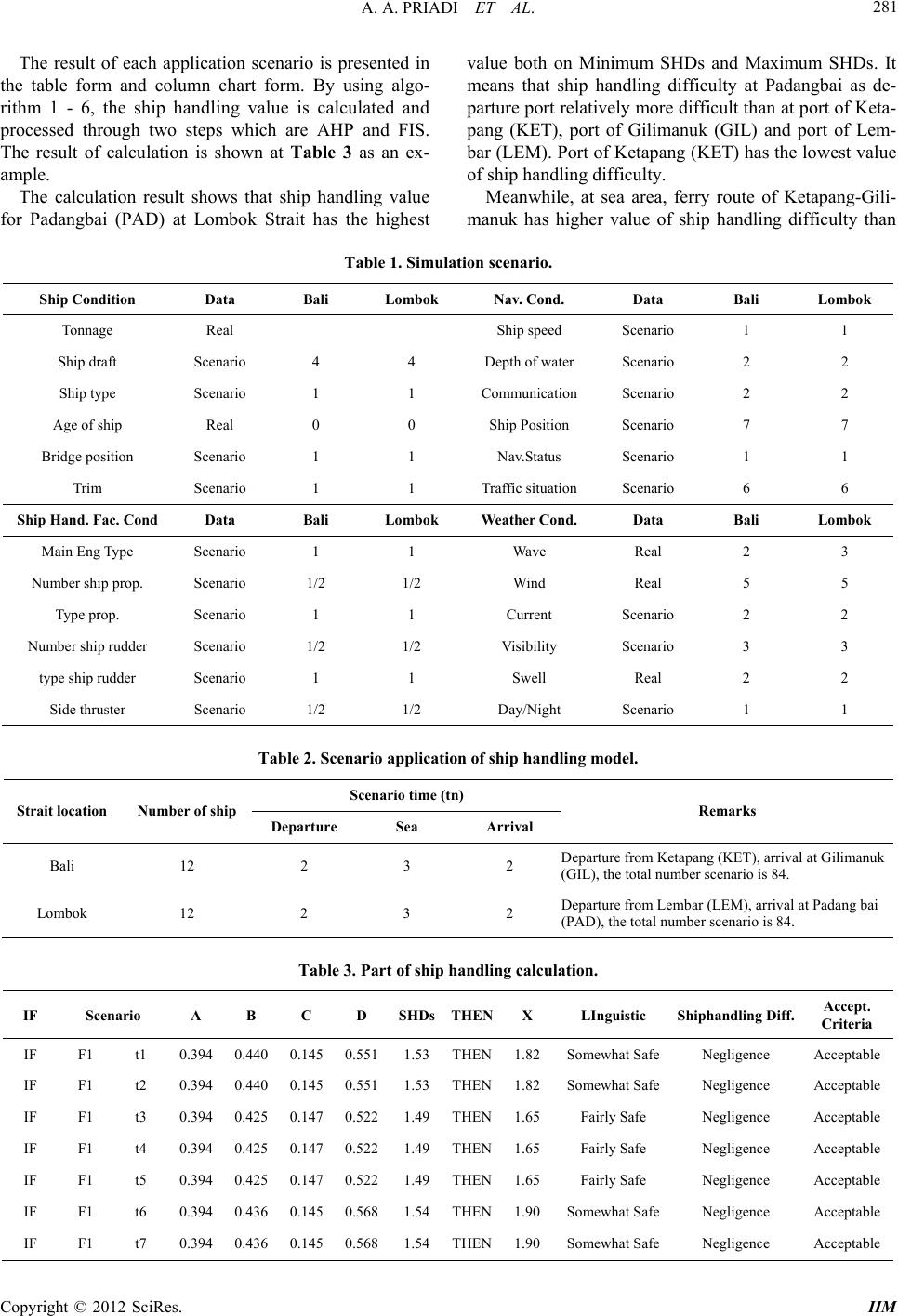 A. A. PRIADI ET AL. 281 The result of each application scenario is presented in the table form and column chart form. By using algo- rithm 1 - 6, the ship handling value is calculated and processed through two steps which are AHP and FIS. The result of calculation is shown at Table 3 as an ex- ample. The calculation result shows that ship handling value for Padangbai (PAD) at Lombok Strait has the highest value both on Minimum SHDs and Maximum SHDs. It means that ship handling difficulty at Padangbai as de- parture port relatively more difficult than at port of Keta- pang (KET), port of Gilimanuk (GIL) and port of Lem- bar (LEM). Port of Ketapang (KET) has the lowest value of ship handlin g difficult y . Meanwhile, at sea area, ferry route of Ketapang-Gili- manuk has higher value of ship handling difficulty than Table 1. Simulation scenario. Ship Condition Data Bali Lombok Nav. Cond. Data Bali Lombok Tonnage Real Ship speed Scenario 1 1 Ship draft Scenario 4 4 Depth of water Scenario 2 2 Ship type Scenario 1 1 Communication Scenario 2 2 Age of ship Real 0 0 Ship Position Scenario 7 7 Bridge position Scenario 1 1 Nav.Status Scenario 1 1 Trim Scenario 1 1 Traffic situation Scenario 6 6 Ship Hand. Fac. Cond Data Bali Lombok Weather Cond. Data Bali Lombok Main Eng Type Scenario 1 1 Wave Real 2 3 Number ship prop. Scenario 1/2 1/2 Wind Real 5 5 Type prop. Scenario 1 1 Current Scenario 2 2 Number ship rudder Scenario 1/2 1/2 Visibility Scenario 3 3 type ship rudder Scenario 1 1 Swell Real 2 2 Side thruster Scenario 1/2 1/2 Day/Night Scenario 1 1 Table 2. Scenario application of ship handling model. Scenario time (tn) Strait location Number of ship Departure Sea Arrival Remarks Bali 12 2 3 2 Departure from Ketapang (KET), arrival at Gilimanuk (GIL), the total number scenario is 84. Lombok 12 2 3 2 Departure from Lembar (LEM), arrival at Padang bai (PAD), the total number scenario is 84. Table 3. Part of ship handling calculation. IF Scenario A B C D SHDsTHENX LInguistic Shiphandling Diff. Accept. Criteria IF F1 t1 0.394 0.440 0.145 0.5511.53 THEN1.82 Somewhat SafeNegligence Acceptable IF F1 t2 0.394 0.440 0.145 0.5511.53 THEN1.82 Somewhat SafeNegligence Acceptable IF F1 t3 0.394 0.425 0.147 0.5221.49 THEN1.65 Fairly Safe Negligence Acceptable IF F1 t4 0.394 0.425 0.147 0.5221.49 THEN1.65 Fairly Safe Negligence Acceptable IF F1 t5 0.394 0.425 0.147 0.5221.49 THEN1.65 Fairly Safe Negligence Acceptable IF F1 t6 0.394 0.436 0.145 0.5681.54 THEN1.90 Somewhat SafeNegligence Acceptable IF F1 t7 0.394 0.436 0.145 0.5681.54 THEN1.90 Somewhat SafeNegligence Acceptable Copyright © 2012 SciRes. IIM 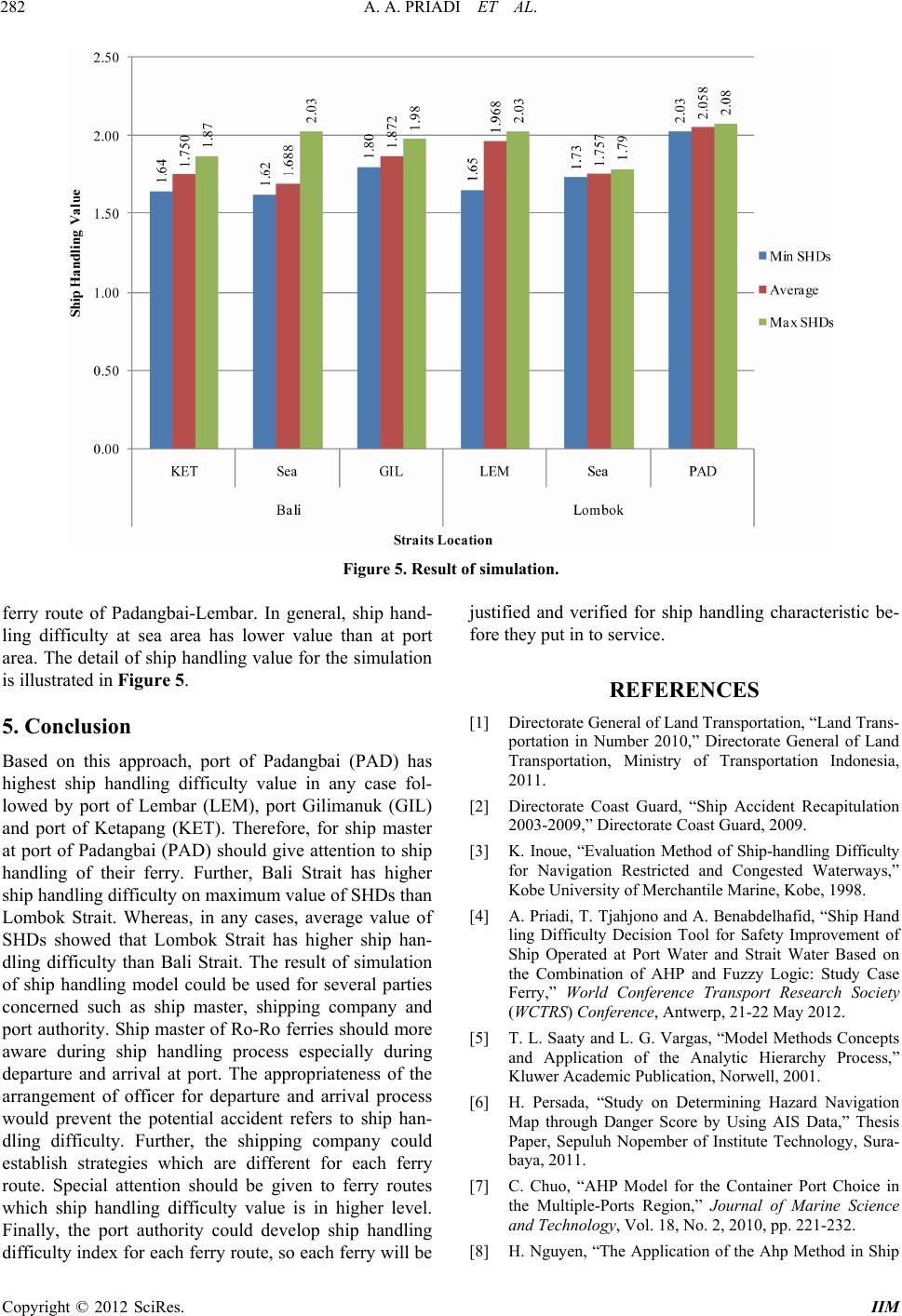 A. A. PRIADI ET AL. 282 Figure 5. Result of simulation. ferry route of Padangbai-Lembar. In general, ship hand- ling difficulty at sea area has lower value than at port area. The detail of ship handling value for the simulation is illustrated in Figure 5. 5. Conclusion Based on this approach, port of Padangbai (PAD) has highest ship handling difficulty value in any case fol- lowed by port of Lembar (LEM), port Gilimanuk (GIL) and port of Ketapang (KET). Therefore, for ship master at port of Padangbai (PAD) should give attention to ship handling of their ferry. Further, Bali Strait has higher ship handling difficulty on maximum valu e of SHDs than Lombok Strait. Whereas, in any cases, average value of SHDs showed that Lombok Strait has higher ship han- dling difficulty than Bali Strait. The result of simulation of ship handling model could be used for several parties concerned such as ship master, shipping company and port authority. Ship master of Ro-Ro ferries should more aware during ship handling process especially during departure and arrival at port. The appropriateness of the arrangement of officer for departure and arrival process would prevent the potential accident refers to ship han- dling difficulty. Further, the shipping company could establish strategies which are different for each ferry route. Special attention should be given to ferry routes which ship handling difficulty value is in higher level. Finally, the port authority could develop ship handling difficulty index for each ferry route, so each ferry will be justified and verified for ship handling characteristic be- fore they put in to service. REFERENCES [1] Directorate General of Land Transportation, “Land Trans- portation in Number 2010,” Directorate General of Land Transportation, Ministry of Transportation Indonesia, 2011. [2] Directorate Coast Guard, “Ship Accident Recapitulation 2003-2009,” Directorate Coast Guard, 2009. [3] K. Inoue, “Evaluation Method of Ship-handling Difficulty for Navigation Restricted and Congested Waterways,” Kobe University of Merchantile Marine, Kobe, 1998. [4] A. Priadi, T. Tjahjono and A. Benabdelhafid, “Ship Hand ling Difficulty Decision Tool for Safety Improvement of Ship Operated at Port Water and Strait Water Based on the Combination of AHP and Fuzzy Logic: Study Case Ferry,” World Conference Transport Research Society (WCTRS) Conference, Antwerp, 21-22 May 2012. [5] T. L. Saaty and L. G. Vargas, “Model Methods Concepts and Application of the Analytic Hierarchy Process,” Kluwer Academic Publication, Norwell, 2001. [6] H. Persada, “Study on Determining Hazard Navigation Map through Danger Score by Using AIS Data,” Thesis Paper, Sepuluh Nopember of Institute Technology, Sura- baya, 2011. [7] C. Chuo, “AHP Model for the Container Port Choice in the Multiple-Ports Region,” Journal of Marine Science and Technology, Vol. 18, No. 2, 2010, pp. 221-232. [8] H. Nguyen, “The Application of the Ahp Method in Ship Copyright © 2012 SciRes. IIM 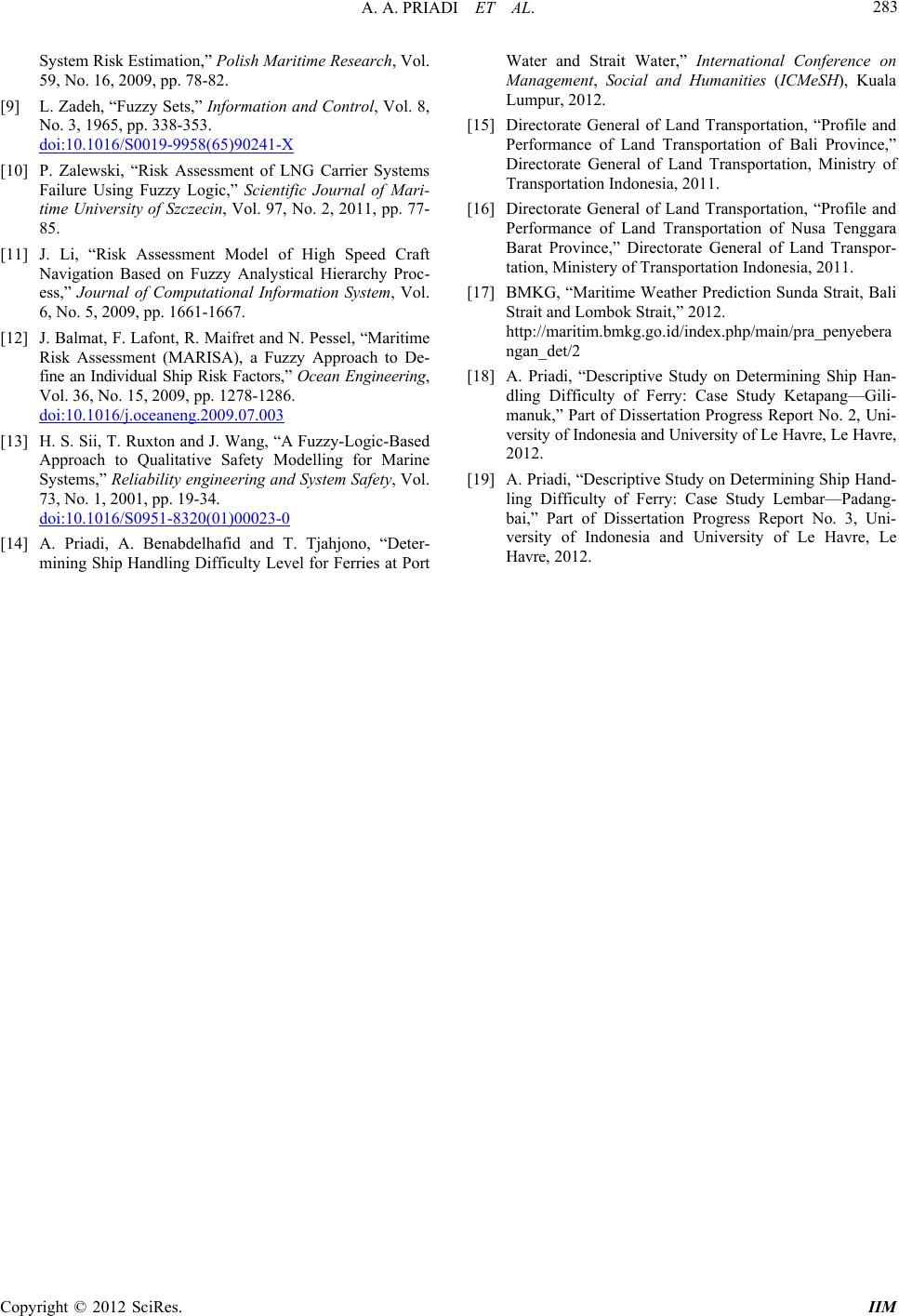 A. A. PRIADI ET AL. 283 System Risk Estimation,” Polish Maritime Research, Vol. 59, No. 16, 2009, pp. 78-82. [9] L. Zadeh, “Fuzzy Sets,” Information and Control, Vol. 8, No. 3, 1965, pp. 338-353. doi:10.1016/S0019-9958(65)90241-X [10] P. Zalewski, “Risk Assessment of LNG Carrier Systems Failure Using Fuzzy Logic,” Scientific Journal of Mari- time University of Szczecin, Vol. 97, No. 2, 2011, pp. 77- 85. [11] J. Li, “Risk Assessment Model of High Speed Craft Navigation Based on Fuzzy Analystical Hierarchy Proc- ess,” Journal of Computational Information System, Vol. 6, No. 5, 2009, pp. 1661-1667. [12] J. Balmat, F. Lafont, R. Maifret and N. Pessel, “Maritime Risk Assessment (MARISA), a Fuzzy Approach to De- fine an Individual Ship Risk Factors,” Ocean Engineering, Vol. 36, No. 15, 2009, pp. 1278-1286. doi:10.1016/j.oceaneng.2009.07.003 [13] H. S. Sii, T. Ruxton and J. Wang, “A Fuzzy-Logic-Ba sed Approach to Qualitative Safety Modelling for Marine Systems,” Reliability engineering and System Safety, Vol. 73, No. 1, 2001, pp. 19-34. doi:10.1016/S0951-8320(01)00023-0 [14] A. Priadi, A. Benabdelhafid and T. Tjahjono, “Deter- mining Ship Handling Difficulty Level for Ferries at Port Water and Strait Water,” International Conference on Management, Social and Humanities (ICMeSH), Kuala Lumpur, 2012. [15] Directorate General of Land Transportation, “Profile and Performance of Land Transportation of Bali Province,” Directorate General of Land Transportation, Ministry of Transportation Indonesia, 2011. [16] Directorate General of Land Transportation, “Profile and Performance of Land Transportation of Nusa Tenggara Barat Province,” Directorate General of Land Transpor- tation, Ministery of Transportation Indonesia, 2011. [17] BMKG, “Maritime Weather Prediction Sunda Strait, Bali Strait and Lombok Strait,” 2012. http://maritim.bmkg.go.id/index.php/main/pra_penyebera ngan_det/2 [18] A. Priadi, “Descriptive Study on Determining Ship Han- dling Difficulty of Ferry: Case Study Ketapang—Gili- manuk,” Part of Dissertation Progress Report No. 2, Uni- versity of Indonesia and Unive rsity of Le Havre, Le Havre, 2012. [19] A. Priadi, “Descriptive Study on Determining Ship Hand- ling Difficulty of Ferry: Case Study Lembar—Padang- bai,” Part of Dissertation Progress Report No. 3, Uni- versity of Indonesia and University of Le Havre, Le Havre, 2012. Copyright © 2012 SciRes. IIM
|